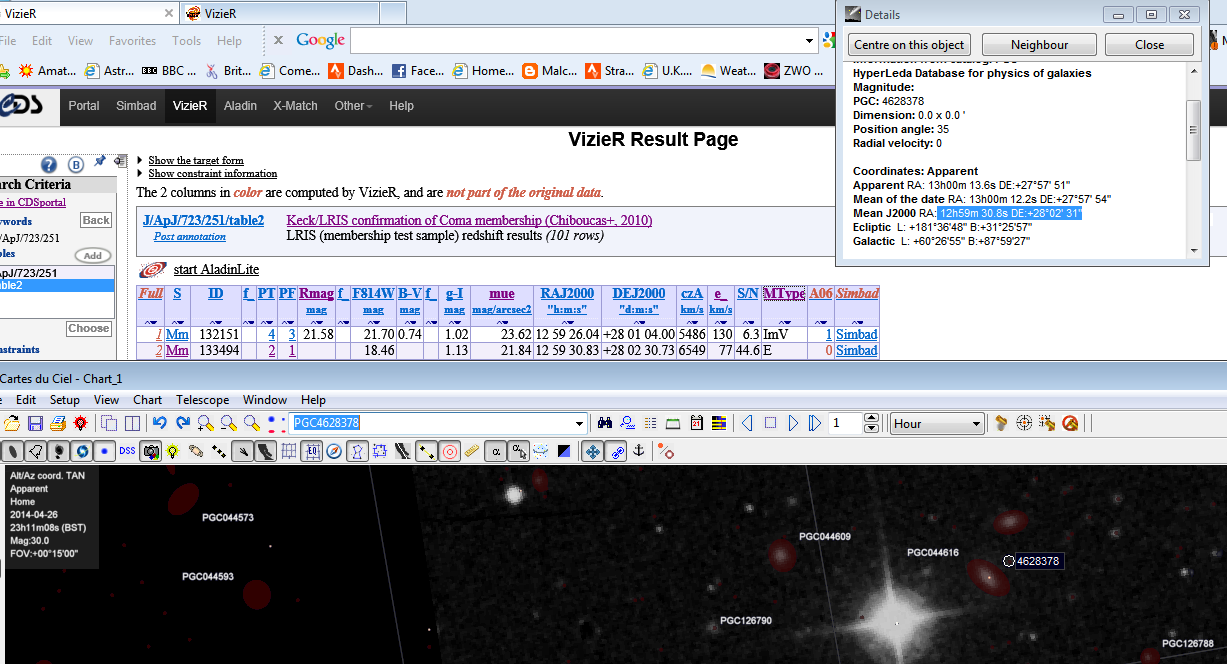I started with the accumulation of 3 hours in 20 minute subs with flats using the William Optics GT81 and starlight express camera. Resolution was 3.37"/pixel with a field of view at 2.83° x 1.88°. I also captured another 5 hours 40 minutes from the FLT110 TMB with darks and flats. Resolution would provide 2.09"/pixel. in a 1.75° x 1.17° field. Unfortunatly I did not manage to keep the angle of camera rotation the same so the final fov would be somewhat smaller. Calibration worked reasonably well in Maxim, a few hot pixels remaining not 100% happy with the flats from the 81mm either. The 81mm frames scaled to the 110mm's ok though. Processed with just levels and curves in photoshop. Definately a gradient there. I will have a go at that later.
 Platesolved in Maxim DL and compared against Carte du ceil. I have several faint galaxy catalogues added and immediately CDC filled with little round circles. I am certainly not going to label all of these???. With probably only a few dozen of our own galaxies stars in the field, everything else is a galaxy mostly from the Coma cluster. This is where the fun begins. CDC labels the PGC galaxies to magnitude 20 anything deeper just leaves a blank. One particular example was labelled PGC 4628378. Listed as 0.0 x 0.0 ' in size and no magnitude it states it's listed under the HyperLeda Database for physics of galaxies. A complex search of 13,000 databases made the task somewhat tougher than I expected as there have only 6 bibliographic references have been made since 1950 on this object. The Hyperleda database splits into many sub categories and redesignated our fuzzy as GMP3397. This was confirmed by the use of Aladin and images gathered by the Sloan Digital Sky Survey SDSS. (pictured). I also cross referenced the data with the Keck/LRIS spectroscopic confirmation of Coma cluster dwarf galaxy membership assignments 2010.
Platesolved in Maxim DL and compared against Carte du ceil. I have several faint galaxy catalogues added and immediately CDC filled with little round circles. I am certainly not going to label all of these???. With probably only a few dozen of our own galaxies stars in the field, everything else is a galaxy mostly from the Coma cluster. This is where the fun begins. CDC labels the PGC galaxies to magnitude 20 anything deeper just leaves a blank. One particular example was labelled PGC 4628378. Listed as 0.0 x 0.0 ' in size and no magnitude it states it's listed under the HyperLeda Database for physics of galaxies. A complex search of 13,000 databases made the task somewhat tougher than I expected as there have only 6 bibliographic references have been made since 1950 on this object. The Hyperleda database splits into many sub categories and redesignated our fuzzy as GMP3397. This was confirmed by the use of Aladin and images gathered by the Sloan Digital Sky Survey SDSS. (pictured). I also cross referenced the data with the Keck/LRIS spectroscopic confirmation of Coma cluster dwarf galaxy membership assignments 2010.This was starting to gather pace like finding a great great great uncle on Ancestry.com.
Using the VizieR Online Data Catalog: GMP catalogue: galaxies in the Coma cluster (Godwin+ 1983). Classification confirms it is a galaxy within the cluster one of 6724 with a magnitude >21 in a 26.3 degree square area centered on the Coma cluster.
Size appears to be 6 x 4 arc seconds. So resolving at 2.09"/pixel that would equate to around 3 pixels on the camera sensor at magnitude 21.84. Bottom left is a 800x zoom and inverted image of the location, CDC photographic plate is on the right. Finally on the left show 3 pixels that are a few shades lighter than the background. This confirms the deepest I have ever imaged.
The 2nd line confirms RA and Dec and a magnitude of 21.84






No comments:
Post a Comment